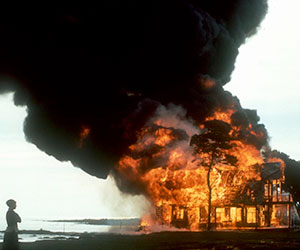Andrei Tarkovsky
Universe
Dreams of Home in the Films of Andrei Tarkovsky
Article by Elena Ringo
Abstract - In this paper the author writes about the metaphorical meaning of the dream about the wooden house in Tarkovsky films, its metamorphosis over time and its connection to the life of the director. This image is one of the most important themes in his films and has a few different interpretations. In order to explain it's meaning the author analyzes the concepts of the films Ivan's Childhood, Mirror, Solaris, Nostalghia, Sacrifice.
Keywords - Andrei Tarkovsky, Ivan's Childhood, Mirror, Solaris, Nostalghia, Sacrifice

Introduction
The dreamlike images of home present in many of Andrei Tarkovsky's films have an allegorical meaning and reflect the transformation of the conscious and of the subconscious world of the author.
Andrei Tarkovsky is renowned for metaphorical language, philosophical dialogue, esoteric symbolism and the blending between the subjective and objective.
In his memoir Sculpting in Time, Tarkovsky explains his views on the role of ambiguity in art:
"By means of art man takes over reality through a subjective experience . . . An artistic discovery occurs each time as a new and unique image of the world, a hieroglyph of absolute truth. It appears as a revelation, as a momentary, passionate wish to grasp intuitively and to touch all the laws of this world—its beauty and ugliness, its compassion and cruelty, its infinity and limitations . . . Through the image is sustained an awareness of the infinite: the eternal within the finite, the spiritual within matter, the limitless given form.''
Instead of presenting us simple images of the past, Tarkovsky is presenting us the character's memory in such a way, that reality and dream are often blended into each other.
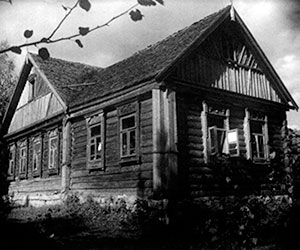
Film critic Maya Turovskaya writes about special significance of the past in Tarkovsky's films:
"The past always exists on equal footing with the present; the world of the imagination coexists with the real world. It would not be an exaggeration to say that these are as real and as present as the elements of the actual plot …what Tarkovsky presents as dreams, as imaginings, as memories…is the element in which a character exists and has his being, is his ‘individual stream of time' that exists alongside the time of the plot. In this scheme of things all moments in time are co-equal, existing alongside the ostensible plot.''
In "Ivan's Childhood", the first feature film of Tarkovsky, the memory of home and the dream about a wooden house confronts the reality of war. The contrast of dream and reality is extremely painful, unbearable to the child. The hero is homeless and such a "homeless" state is important to the portrait of the hero, who first appears in the film as stubborn boy in wet rags, barely alive from exhaustion.
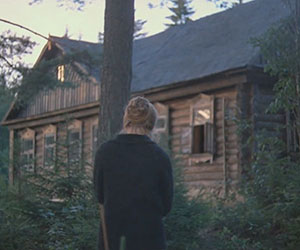
Dreams of Ivan are the state where you for a moment forget about the brutal reality of war and recollect the other peaceful reality.
Ivan's dreams reflect the dreams of Tarkovsky himself, whose life was also damaged by the cruel reality of the war.
All the memories of Ivan are associated with pain - the death of the mother, who was shot in front of him, his dreams are dreams of the return to the lost childhood.
His dreams are real, fuller and more picturesque than the cruel reality, which often looks like a recurring nightmare.
Pieces of the past have turned into dreams, where there is an ideal childhood which subsequently ends in a brutal way.
Tarkovsky himself explained these dreams:
"All the dreams (four of them) are based on associations. The first dream for example all from the beginning to the end until the line "Mom, there's a cuckoo!" It is one of the earliest memories of my childhood. It was my first acquaintance with the world. I was only four years old "- said the director.
This memory transformed into a famous shot - a tanned face of a boy who listens to the silence of towering pine trees against the background of a white spider web. The camera goes up - on the tree trunk between the branches. Then the camera comes close to the boy and captures the state of serenity and free spirit.
"When filming the picture we were confronted with the need to film dreams we had to answer the question: how to get closer to the poetic authenticity, how to express it, by what means? … So suddenly I came up with the idea of a negative image in the third dream. In our mind the glare of the sun flashed black through the snowy trees and a sparkling rain flowed. So the lightning flashes showed the technical possibility of switching from positive to negative ".
Rhythmic structure of the film emphasizes the gap between the past and the present, the time of childhood and the time of war. This split is associated with the violent death of the Ivan's mother.
The image of Ivan's home is not so obvious as in the other films by the director, because he wanted to emphasize that the boy is homeless.
In "Ivan's Childhood" "homelessness" represents the mad logic of war.
Visual images of "Ivan's Childhood" combine poetic techniques, freely moving camera, expressive metaphors - stylistic methods, inspired by the films of Kalatozov and a courageous search of a new cinematographic language based on the poetic cinema of the 20s.
Another theme of "Ivan's Childhood" which became prevalent in the artistic world of Tarkovsky – an author's vision about the image of time and dreams. The director makes an unexpected, abrupt transition from private shots of the hero, then to the chronicle of the capture of Berlin, and then to the episode in which Galtsev, defeated, in the Reich Chancellery in Berlin finds a document that shows that Ivan was sentenced to death.
The logic of filming is transforming its rhythm, abandoning the calendar time, leaving his sequence of individual flashbacks, drawing the path of the inner journey of the individual. This understanding of time will determine the principle of "Mirror" in which Tarkovsky returns to the theme of dreams and the child-hero.
Perhaps "The Mirror'' is the most mysterious and intimate film by Tarkovsky.
Here again Tarkovsky deals with the memories of lost time.
But the idea of the film "The Mirror" did not turn into an elegiac story of a gone time, but established a vital connection between "child" time and "adult'' time.
The image of the old wooden house, or dacha, which looks like Tarkovsky's dacha, was very important for the film.
The image of the home is tightly connected to subconsciousness of the hero's and the author himself. The idealization of home in memory allows each character a mental escape from reality; however, it is never that simple to escape into the past.
The filmmaker carefully recreates the environment of their childhood memories by trying to accurately to convey his feelings to the audience.
A log house of the childhood hero in the beginning of the film “The Mirror”, The memory of the mother washing the child's face from the well is replaced by a spacious city apartment with high ceilings - a slow journey of the camera in the hallway and rooms which return the viewer to the present. Tarkovsky's house reconstructed in detail with its furnishings and layout is the most important image in the film.
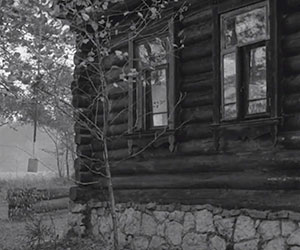
Tarkovsky said in an interview that it is important to understand how a film can develop itself. The process of "self-development" began with the reconstruction of the environment where the director was born and where he spent his childhood from his old photos.
"In front of the house there was a field. I seem to recall that between the house and the road leading to the nearby village, was a field of buckwheat. It was very beautiful when in bloom. The color is white, which makes the field look snowy, it remained in my memory as a distinctive and significant detail of my childhood memories."
In an interview Tarkovsky told about how the crewmembers arrived in this place and found that the field was covered with clover for many years, and were waiting patiently for the moment when it would bloom.
Birth of the flowers on the field was vitally connected with the birth of the film "The Mirror". Agricultural work began the creative process on location creating the magical world of the future picture.
In "The Mirror" the attention was focused on images of a particular house, the farm and the surrounding natural world in their textural and temporal uniqueness. The hero is closely associated with the time and inseparable from the holistic perception of the era.
In his memoirs, the author said that the field was an extension of the house, as well as the nearby forest, where the brother and the sister often picked berries.
"There's something that pulls you back into the past, leaving nothing ahead. It is always very difficult. I thought that by listening to it, I thus would be free from it. By the way, in Proust, I read that it helps to get rid of these things, and in Freud it is written. "
Something that will forever remain in the memory - simple everyday things that create a combination of the elusive image of time: the fence, where his mother was sitting for a long time, looking at the road in the field, and her hair-pinned hair in a high bun, a wave that was scattered by shoulders, when his mother freed them from captivity, how milk is bottled on the plank table, garden after the rain, bellied glass jug with wild flowers on the windowsill.
If in "Ivan's Childhood" dreams about the house and the current reality are divided by the funnel of the war, in the "The Mirror'' the mystery and metaphor of a dream is represented by composition of the narrative, artistic fabric. Between episodes of dreams, memories of the village and farm scenes in the apartment there is the general atmosphere of allegorical happening. Reality and dreams are blending with each other, through their interaction of the hero who continues to live in the space of childhood dreams, trying to unravel the elusive meaning of the events of his own destiny.
Sean Martin writes on psyche and home;
“As if reflecting dream logic…the interiors of these dachas are always ambiguously arranged, with rooms seemingly moving around in relation to one another”.
Tarkovsky wrote about the dream, which affected this film:
"With a remarkable consistency I was dreaming the same dream. My grandfather's house where I was born right on the dining room table. Pine trees around the house of my childhood. I'm waiting and I cannot wait for this dream where I see myself as a child again. And every time I want to enter into it, something interferes. I often dream this dream, I'm used to it. And when I see the log walls, darkened by time and the half-open door into the dark passage, I have a dream I know that I can only dream of. And an excessive joy overshadowed anticipation of awakening. Sometimes something happens and I stop dreaming about the house and the pine trees around the house of my childhood. Then I start to miss. I'm waiting and I cannot wait for this dream in which I see myself as a child again, and again feel happy on what is yet to come, yet everything is possible".
One of the most memorable images of dreams in the film - a black and white frame, in which the child comes to the old log house, climbs the steps and pulls the door handle trying to open the door, and then descends down again. The mysterious, gray, silent rustling forest a kind of metaphor for the mysterious transition through time, which is easily done in a dream.
Tarkovsky stressed that he uses "poetic logic in the picture composition, which is just as legitimate as a literary or theatrical and dramatic, though less familiar to the viewer's perception, looking at the sequence of the plot of the story". Even the panoramic view as one of the most common techniques of "The Mirror" is an equivalent of poetic form. Camera movement of G. Rerberg is gradually expands the angle of the viewer.
The fire depicted in the film is a representation of the fleeing time.
Another film of Tarkovsky, Solaris, is also characterized by the dreams about home. However in this film it has another meaning and another form.
Andrei Tarkovsky shot “Solaris” four years after “2001: A Space Odyssey.” In a way it was a response to Kubrick's film. At that time environmental problems became clear - destruction of the natural environment , as well as the crisis of moral values.
Tarkovsky's film is contemplation about the fate of man in the age of technological progress, the fate of our planet, about the traditional ethical values in the modern era. The traditional human values, such as ties with earth, art, and conscience are symbolically represented by the image of the wooden house.

Tarkovsky's film does not argue with the picture of Kubrick. But these movies are diametrically opposed to each other. The protagonist of Kubrick - machinery embodying the mind of man does not interest Tarkovsky, not the environment created by technology of the future.
Kubrick wants to show the technology in the year 2000. Tarkovsky disclaims detailed image of the technology of the future and is committed to psychological authenticity. Only for a moment we can see the contours of the space station fly around the planet Solaris, its corridors and cabins, but they are not are not interesting, what is interesting is the presence of humans in them and their spirit.
What the director is looking for in the future are islands vanished into the past, the old wooden house, mist over the lake, the smoke from the fire – things which were the same a thousand years ago. A painting by Pieter Brueghel symbolizes the beauty of art and harmony of nature. The landscapes by the Dutch artist help the viewer to understand the eternal and essential, what a person must keep at the core of their civilization.
The alternative to these human values is technology, which is represented by a scene, filmed in Japan. The huge tunnel with no beginning and no way out.
The final scenes by Tarkovsky and Kubrick are completely different. Kubrick's film ends with the landing on Jupiter and the journey to infinity.
In Tarkovsky's the hero returns home. We see the old wooden house and the hero kneeling in front of it as a Prodigal Son of Rembrandt. But when the camera moves back we see that the house and the earth on which it stands is only an island in Solaris. The intelligent ocean with the help of Chris creates on the surface plasma a fragment of the Earth's land with a grove around the family home. With the warm rain pouring on the roof and the old father. What is it – Chris's memory or his dream? We never find out. But what is important is his mother, the porch, his father and Chris returning back to the eternal values that are the most important: the beauty of the world's landscape, family, home, art and the moral law within him.
We see that he returns to what he understands as the true meaning of his life.
House of Andrei Tarkovsky, figuratively represented in the "The Mirror", in the global landscape is becoming a symbol of nostalgic journey through space and time and recalling images of lonely human life on Earth.
The dreamlike image of the wooden house is also a central image in a film Nostalghia, which was one of the two films, made by Tarkovsky abroad.
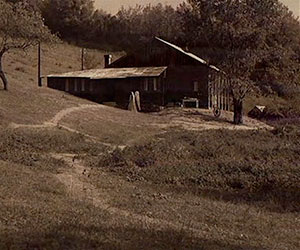
This image is a symbol of a lost motherland and also an image of the lost childhood, youth and lost time. And longing of Gorchakov of his motherland is represented by a dream about his home.
Gorchakov constantly dreams of his Russian home. It is clear only in his dreams that what he truly desires is home. Tarkovsky differentiates Gorchakov's dreams by using black and white film and slow motion. Critic Peter Green notes the importance of this formal separation,
"Andrei's memory is reduced to a schematic signal…his other recollections, visions and dreams are likewise drained of colour…what makes Tarkovsky's films so enigmatic at first sight are these shifts between different planes. He eschewed the familiar convention by which the viewer is prepared for flashback and dream. He cuts or dissolves without an explanatory transition. In doing so he demanded a new cinematographic awareness of his audience…time past and future, dream or vision are juxtaposed on a more or less equal footing with present reality. All states, all times form a continuum.''
By dividing Gorchakov's dreams and Italian reality, Tarkovsky wants to emphasize the idealization the image of home, and in a way, idealization of the passed time, which is also symbolized by the image home. Along with images of the home come depictions of Gorchakov's family. They are part of the idealized reality that Andrei wishes to return to. The film opens and closes with slow tracking shots of Andrei's log house. This is the embodiment of Andrei's nostalgia. He only finds rest when he enters his dream world.
In the end we see how Gorchakov finally returns to his house. It is very near to him and for a moment we think that at last he is back in the beloved motherland. But later when the camera moves back we see that in fact Gorchakov is sitting surrounded by the ruins of the old castle. And this castle represents death; the same was as the ruins of the castle in the film Orpheus by the French director Jean Cocteau represents death. So we see that Gorchakov was able to return to his home, to his motherland and to gain back the lost childhood and youth only in the moment of his death.
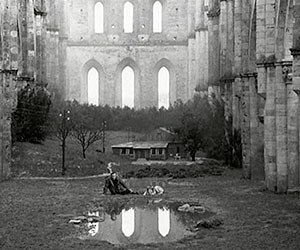
All films by Andrei Tarkovsky are highly metaphorical and, at the same time, autobiographical and represent the different phases of his life. “The Sacrifice”, his last film is no exception.
Again we see the image of a wooden house – the embodiment of stability, motherland, and roots. And in order to save the world the main character had to burn his beloved house, as an ultimate sacrifice. Probably, Tarkovsky wanted to show by this act his own decision to abandon his motherland, his house, to burn all bridges with his homeland.
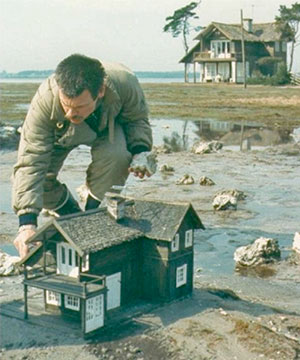
Tarkovsky thought that this act was necessary for him and would help to save his art and the world. However the hero of Sacrifice was not able to survive the loss of his house, as Tarkovsky was not able to survive the loss of his motherland, and at the end of the film they both die - the hero and his creator – director Andrei Tarkovsky. And the film “The Sacrifice” became his testament, as the image of the burning house became one of the most memorable symbols of Tarkovky's cinematography.
